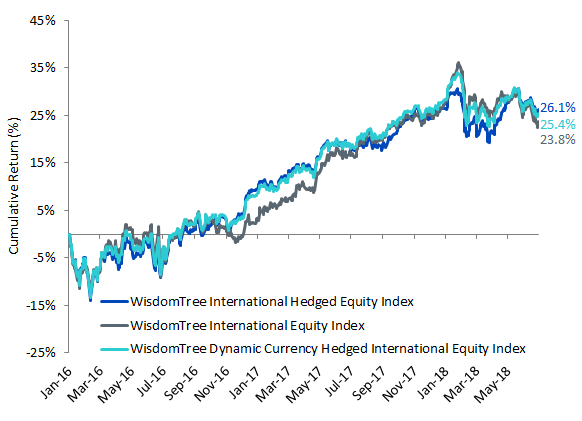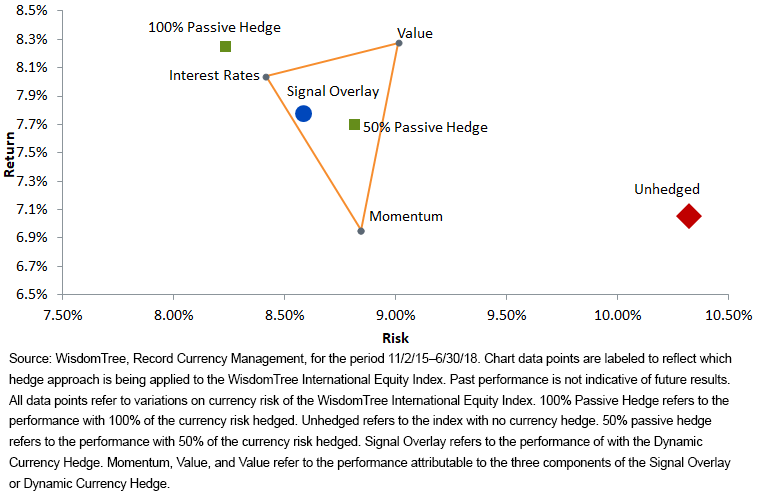How Much Conviction Do You Have in Your Weak Dollar Bets?


One topic on which WisdomTree has a world view that contrasts most sharply with many traditional active asset managers and some investors involves the role of currency risk in driving portfolio returns. Most investors we talk to say they do not want to make a “currency call” but then default to being unhedged in their international investments. By default, they are making the implicit call that the dollar is going to decline forever.
Stated differently, when one invests in European stocks unhedged, one has exposure to the euro plus European stocks. This euro exposure, in our view, adds unrewarded risk—in the sense that there is no risk premium that suggests the euro will appreciate forever, as one is relying on in unhedged equity strategies.
Is it expensive to hedge? Certainly not for the developed world. As the Federal Reserve (Fed) has been hiking rates, investors are now paid 2% plus implied interest rate differentials in forward contracts to hedge the euro and the yen—this interest rate income is not collected in unhedged strategies.
What Is Truly Currency Neutral?
WisdomTree has been advocating since 2009 that a truly currency-neutral policy would be to fully hedge one’s currency risk, and then one should add in that risk when one has a favorable view on that currency or basket of currencies. Most people do not have conviction in these currency calls, which is why WisdomTree believes more people should be hedged as a default.
One other default setting for investors is to let their active managers make currency decisions for them. Now, here is where active managers often will say we are “stock pickers,” not currency experts, yet their default setting also is to bet long on the euro.
Having a Plan and Sticking to It
My friends Ben Carlson and Michael Batnick on their “Animal Spirits” podcast have touched on this currency topic a few times; their view often comes down to there being “no right answer” and that the most important thing for investors is to have a plan and stick to it. If one tries to time the currency call, many will have a great chance of rotating between hedged and unhedged strategies at the wrong time. I agree with that sentiment if one does not have a world view on how best to manage this risk.
However, just as there are well-documented equity factors that have ample evidence to suggest one can earn different “factor” risk premiums, WisdomTree believes there are similar factors at play in the currency markets that overlap with the equity factors.
Two of the factors are often discussed: value and momentum. These are two factors on opposing sides; value stocks or value currencies would tend to be ones that have been depreciating, while momentum is following price trends higher. In currencies, we evaluate value with an intrinsic fair value measure of purchasing power parity (PPP). PPP tries to equate baskets of goods in different currencies, also relying on the fact that currencies can become far overvalued and undervalued and will not tend to stay close to that fair value.
The third factor for currencies is interest rates, or “carry.” This factor helps manage the cost of hedging by only hedging developed-world currencies when one is paid to do so and being unhedged when it costs carry. This signal calls for hedging broadly today given the divergent global central bank policies: the Fed is hiking rates, and many foreign central banks are still in negative interest rate territory.
We now have two and a half years of real-time performance of WisdomTree’s dynamically hedged currency suite of strategies that incorporate a rules-based approach to add hedges on this three-factor currency model. During this time period, we’ve had some dramatic currency cycles.
- 2016 was a very strong dollar environment, and one can see the WisdomTree dynamically hedged Index keeping up with the fully hedged WisdomTree Index during 2016.
- 2017 was a weak dollar period in which the dollar declined 8.5%1 and unhedged strategies got a currency kicker through the first quarter of 2018.
- In the second quarter of 2018, the dollar appreciated 5.5%,2 sending hedged indexes ahead of unhedged indexes over the full two-and-a-half-year period that WisdomTree’s dynamically hedged Index has been live.
Since 2016: WisdomTree Dynamic Currency Hedged Compared to Unhedged and Fully Hedged
WT International Indexes


From a risk attribution perspective, one of the dynamics that is clear: the strategy that has the most risk is WisdomTree’s unhedged Index. A 50% passive hedge is the best benchmark for this dynamically hedged Index because it will rotate around 50% hedge ratios, and in real time the hedge has been between 40% to 80%.
WisdomTree International Equity Index under Different Currency-Hedging Approaches

Dynamic Signal Overlay: Three-Factor Model
The signal overlay in the risk attribution box combines the value signal, momentum signal, and carry signal into this three-factor currency model.
Of the single-factor signals, interest rates over this period had the greatest risk reduction because they suggested the highest hedge ratios. This is because of how much the Fed has been hiking rates. In 2017, this signal did not work as the dollar declined, but still the risk reduction is evident. Value from a return perspective has been a value-added signal over the last two and a half years because it helped reduce hedge ratios on the euro before its rally in 2017. The momentum signal has helped reduce risk over the last two and a half years, but it has been the weakest of signals from a return perspective.
Over long-enough currency cycles, which we think of as five to seven years, we believe the signal overlay can outperform hedged, unhedged and 50% hedged benchmarks. Over the last two and a half years, we see that the dynamic signal overlay has now outperformed unhedged and 50% hedged benchmarks, while reducing risk of unhedged indexes by 174 basis points per year.
Overseas equities are often perceived as “riskier” than U.S. equities—but one of the factors that makes them riskier is currency, as we discussed here. Whether one employs a fully hedged, a 50% passive hedge or a dynamic hedge to add value over a 50/50 benchmark, this risk chart helps showcase the one strategy WisdomTree would suggest avoiding over the long run: being unhedged all the time.
1Source: Bloomberg, for the period 12/30/16–12/29/17, based on the Bloomberg Dollar Spot Index.
2Source: Bloomberg, for the period 3/29/18–6/29/18, based on the Bloomberg Dollar Spot Index.
Important Risks Related to this Article
Hedging can help returns when a foreign currency depreciates against the U.S. dollar but can hurt when the foreign currency appreciates against the U.S. dollar.

Jeremy Schwartz has served as our Global Chief Investment Officer since November 2021 and leads WisdomTree’s investment strategy team in the construction of WisdomTree’s equity Indexes, quantitative active strategies and multi-asset Model Portfolios. Jeremy joined WisdomTree in May 2005 as a Senior Analyst, adding Deputy Director of Research to his responsibilities in February 2007. He served as Director of Research from October 2008 to October 2018 and as Global Head of Research from November 2018 to November 2021. Before joining WisdomTree, he was a head research assistant for Professor Jeremy Siegel and, in 2022, became his co-author on the sixth edition of the book Stocks for the Long Run. Jeremy is also co-author of the Financial Analysts Journal paper “What Happened to the Original Stocks in the S&P 500?” He received his B.S. in economics from The Wharton School of the University of Pennsylvania and hosts the Wharton Business Radio program Behind the Markets on SiriusXM 132. Jeremy is a member of the CFA Society of Philadelphia.

